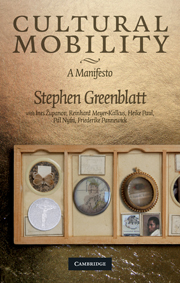Book contents
- Frontmatter
- Contents
- List of authors
- List of illustrations
- Acknowledgments
- 1 Cultural mobility: an introduction
- 2 “The Wheel of Torments”: mobility and redemption in Portuguese colonial India (sixteenth century)
- 3 Theatrical mobility
- 4 World literature beyond Goethe
- 5 Cultural mobility between Boston and Berlin: how Germans have read and reread narratives of American slavery
- 6 Struggling for mobility: migration, tourism, and cultural authority in contemporary China
- 7 Performativity and mobility: Middle Eastern traditions on the move
- 8 A mobility studies manifesto
- Index
- References
6 - Struggling for mobility: migration, tourism, and cultural authority in contemporary China
Published online by Cambridge University Press: 05 June 2012
- Frontmatter
- Contents
- List of authors
- List of illustrations
- Acknowledgments
- 1 Cultural mobility: an introduction
- 2 “The Wheel of Torments”: mobility and redemption in Portuguese colonial India (sixteenth century)
- 3 Theatrical mobility
- 4 World literature beyond Goethe
- 5 Cultural mobility between Boston and Berlin: how Germans have read and reread narratives of American slavery
- 6 Struggling for mobility: migration, tourism, and cultural authority in contemporary China
- 7 Performativity and mobility: Middle Eastern traditions on the move
- 8 A mobility studies manifesto
- Index
- References
Summary
In Manhattan's Chinatown, illegal migrants from Fujian Province, on a break from work in Chinese-owned garment workshops, buy telephone cards with Chinese instructions from Chinese vendors in order to call home. Can their experience of mobility, and the way that experience makes them relate to China, be understood in the same framework as that of a middle-class Chinese tourist at a popular “scenic spot” in China? Do these very different situations point to something common in terms of how newfound mobility is affecting subjectivity and its state conditioning in China? In this chapter, I suggest that both individuals have to negotiate their positions as modern Chinese subjects as they cope with contradiction between the expectation of mobility and barriers in front of it. While unifying and mobilizing images of Chinese modernity are transmitted to them through a range of media technologies from telephone cards to tourist brochures, they have to make their way through everyday situations and contradictory local discourses that stand in the way of movement and strip them of their enfranchisement.
Chinatown, Manhattan, March 7, 2001
At the Yidong Shopping Center at 88 East Broadway in Manhattan, Fujianese vendors sell international telephone cards. One vendor stocks fifty-one kinds, many with Chinese text and distinctive design. On one card, called Great Wall, Deng Xiaoping extends his congratulations on the return of Hong Kong to the Motherland.
- Type
- Chapter
- Information
- Cultural MobilityA Manifesto, pp. 172 - 214Publisher: Cambridge University PressPrint publication year: 2009



